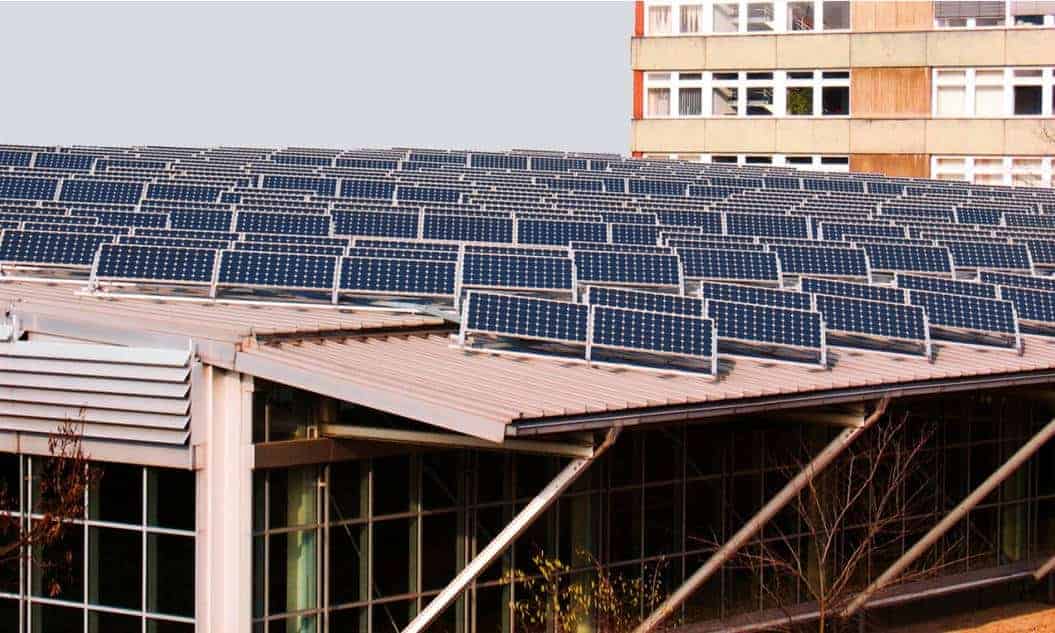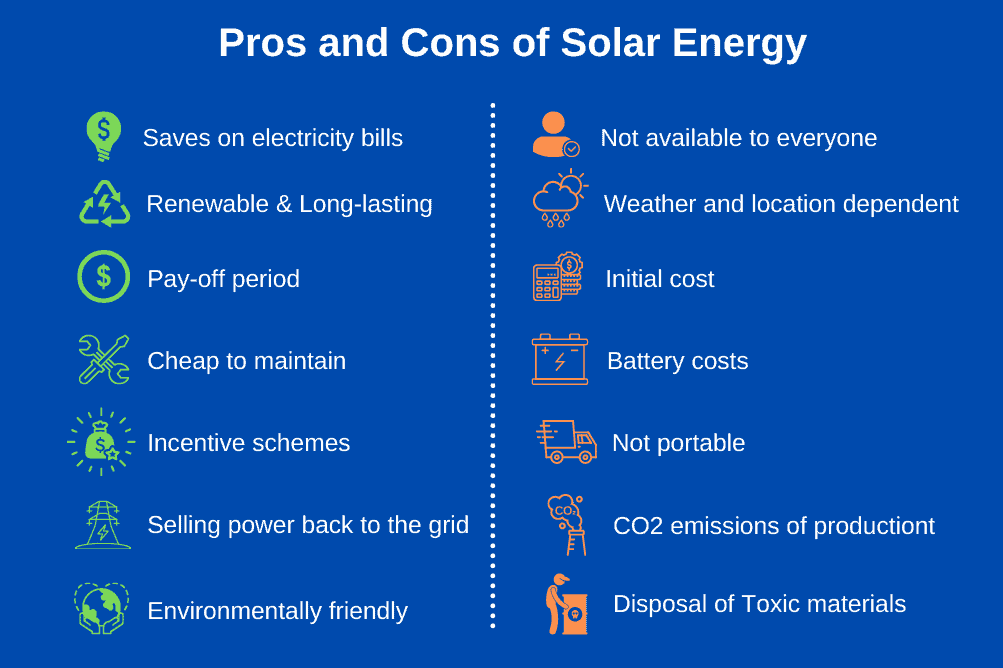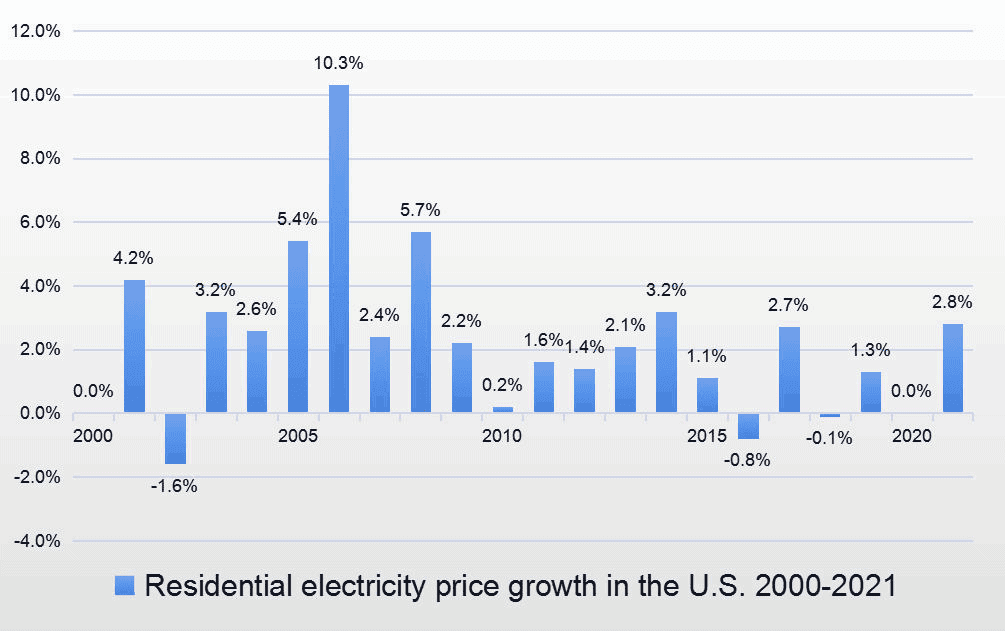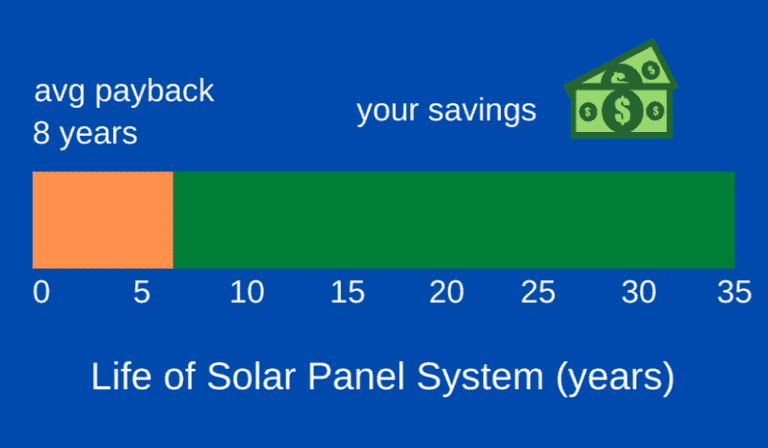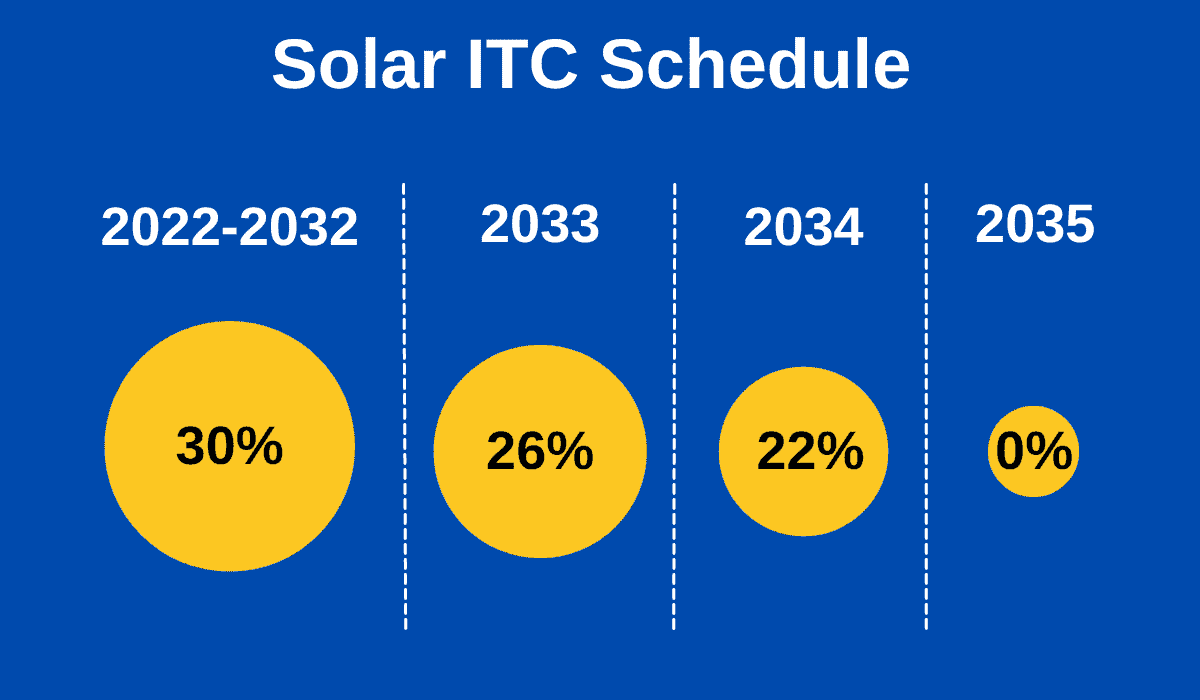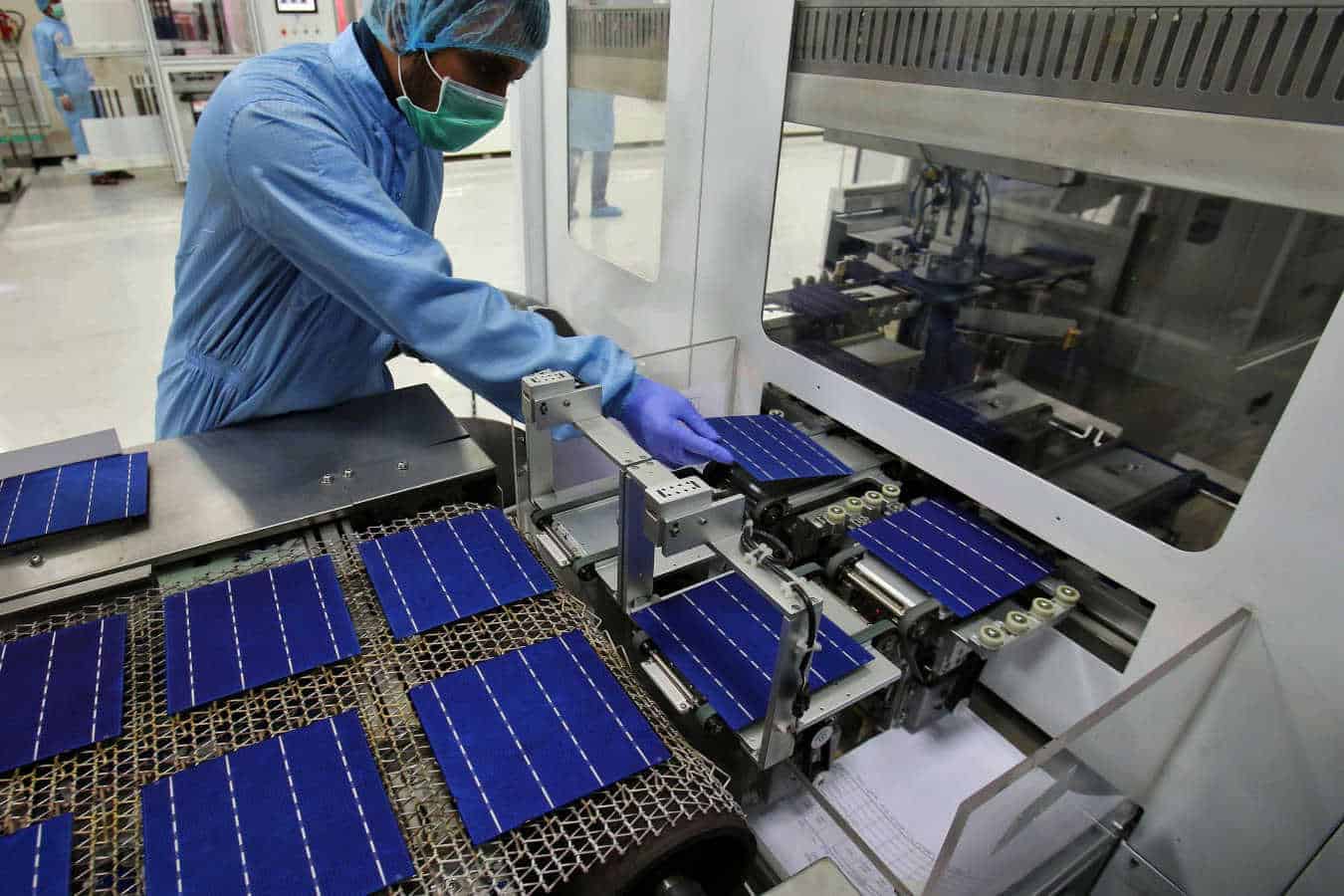Solar energy is an increasingly popular home energy solution. It offers the promise of a cheap renewable energy source that can save you a significant amount on your electricity bills while reducing the amount of electricity you derive from non-renewable polluting fuels.
But I’ve also read some negative things about solar power, questions about how to clean an energy source it really is, and uncertainty about whether a solar system will save you enough money to justify the initial expense.
To make an informed choice we must look at all the positive aspects of solar energy and weigh them against the negatives. To help you get the full lowdown on the pros and cons of solar energy, I’ve listed them below, so why not have a read-through and judge for yourself?
Solar Energy Pros
1) Saves on electricity bills
From the day you install your solar system and connect it to your power supply, you start saving money on your electricity bills. How much you save depends on the system size, but a big enough solar system could reduce your electricity bill to zero.
The system size you need varies depending on the amount of energy you use and your home location. Estimates suggest installing between 21 and 34 solar panels can provide enough energy to reduce your electricity bill to zero.
For more detail read: How Many Solar Panels Do I Need to Power My Home?[
2) Protects against future electricity price rises
The cost of electricity in real terms has been rising for decades. It will only become more difficult to get gas, oil, and coal as these non-renewable energy sources are exhausted, so it’s reasonable to expect this trend of increasing electricity costs to continue.
Setting up a home solar system as a renewable and constant source of power is a great way to ensure against these future increases in electricity costs.
3) Renewable
The sun is going to keep shining for another 5 billion years. The sun is going to keep shining for another 5 billion years. It’s the ultimate renewable energy source because all you need to do is point a solar cell at it to draw from a regular and free energy supply. Solar power is a great way to reduce your carbon footprint and provide your home with a constant and renewable energy supply.
4) Long-lasting
One of the beauties of generating electricity using solar panels is that there aren’t any moving parts. The photovoltaic solar cells in a solar panel generate power through a chemical reaction in a sealed unit and so solar panels are exceptionally long-lasting.
Most home solar panels have a twenty-five-year warranty, and their efficiency only reduces very slightly over this lifetime. A solar system is an investment that will reap returns for many years into the future.
5) Pay-off period
Calculating the payoff period of a solar system spreads out the initial investment over the life cycle of the panel. It’s a calculation that looks at the annual electricity savings you get from solar panels and then calculates how many years of savings you need to pay off your initial investment.
Payoff Period = Cost of system ÷ Annual Electricity Savings
A typical payoff period for modern solar systems is around eight years. That means, assuming a twenty-five-year life, your solar system will provide you with free power for seventeen years.
6) Cheap to maintain
Because of the lack of moving parts, home solar systems are straightforward to maintain with occasional cleaning if needed and an annual service. This means the ongoing running costs of home solar are minimal.
Recommended to read: Solar Panel Maintenance – Why & How to Do It?
7) Incentive schemes
Countries are increasingly making commitments to reduce their carbon footprint and generate energy from renewable sources. To achieve these goals, the US federal government offers generous tax rebates for investing in solar energy.
Many states, towns, and utilities offer further discounts, promotions and incentives for investing in solar power. Taken together these incentives can substantially reduce the cost of a home solar system and make the proposal even more attractive to homeowners.
8) Selling power back to the grid
As well as covering powering devices in your home, grid-linked solar systems connect to your mains electricity. If you generate extra electricity, you can sell it back to the grid. Sometimes you can sell this excess power at subsidised premium rates and this provides valuable income to set off against your energy bill.
9) Environmentally friendly
Despite a few environmental issues over the construction of solar systems, it’s safe to conclude that they are much healthier for the environment than traditional fossil fuel methods of generating electricity. Your solar system saves you money and helps the environment. What could be better than that?
10) Scientific advances
Just five years ago, home solar systems weren’t really commercially viable due to their cost and inefficiency in converting solar energy to power. All that has changed now as prices have fallen and energy production has increased. These improvements are ongoing as promising new technologies move from the laboratory into your home. The cost-effectiveness of home solar keeps getting better.
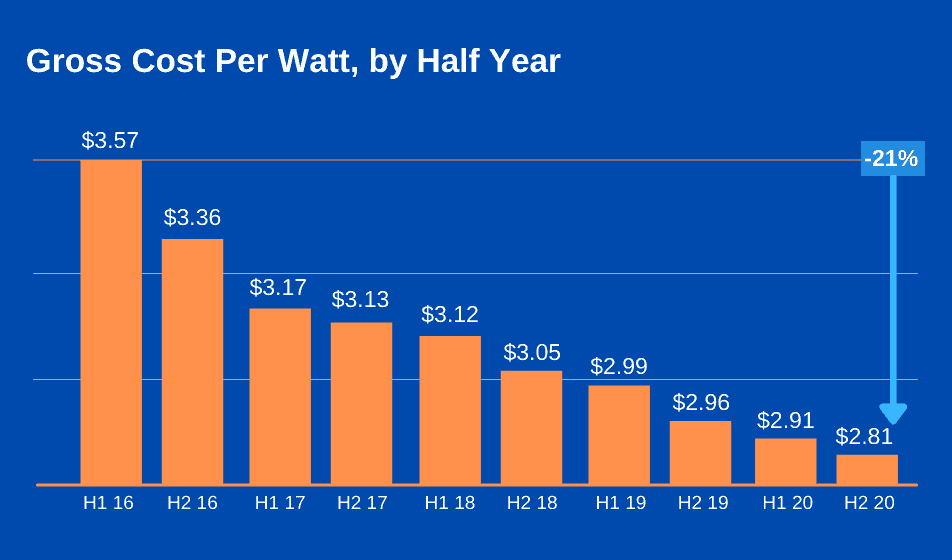
Solar Energy Cons
1) Not available to everyone
A solar panel installation takes up a lot of space. The amount of space required is reducing as the efficiency of solar panels improves, but if you want to generate a meaningful amount of electricity from your home solar system, you’re going to need a lot of roof space.
Not everybody has a roof or a big garden in which to install a solar system. This is especially the case in cities where small homes and apartments lack the space to install solar power.
There isn’t much that we can do about this except incentivize people with a large amount of space for solar power to produce more than their own needs. This is already happening as homes with on-grid solar connections capitalize on the earnings potential of selling excess electricity production back into the grid.
Solar will never be a renewable energy solution for all homes but by rewarding production, it’s possible to share all the solar energy benefits more equitably.
2) Weather and location-dependent
Solar energy works better in clear dry places than cloudy and wet climates that see less sun. This means that home solar produces better returns in some states and locations than others.
3) Initial cost
Despite government incentives and falling system costs, your initial home solar system investment will still be substantial. We’ve established that you can expect excellent long-term returns from your investment, but the fact remains that you need to come up with the money to get it installed in the first place.
4) Battery costs
On-grid solar systems don’t need battery storage, although it’s handy to have if you want to power your home during power cuts. Cheap, high-capacity batteries would significantly improve solar electricity storage. As of now, battery technology has greatly improved and become more affordable due to advancements in technology and increased market competition, although it still represents a significant part of the overall system cost.
5) Not portable
Solar systems are specially tailored to the place where they are installed. This means that if you move home, you can’t just pick up and transport your home’s solar system.
However, a solar installation increases the resale value of your house, and this offers you the chance to recoup your investment if you move.
6) CO2 emissions from production and transport
The mining, assembly, and transport of solar panels and the other components of solar systems have a marked environmental impact and CO2 footprint. But this is the case with most manufactured products. The long-term benefits of renewable solar energy more than makeup for the environmental impact of solar panel manufacture.
7) Disposal of Toxic materials
Some components of solar systems are toxic and difficult to dispose of, particularly the materials that go into batteries. The difficulty of safely disposing of toxic components must be considered when assessing the environmental impact of solar systems.
The long lifespan of solar systems acts in their favor here since the volume and frequency of disposal of toxic material waste are low.
To conclude
Looking at the pros and cons of solar energy can help you decide whether a solar system will provide you with an energy solution. If you have the space, the budget for the initial investment, and a good solar resource, it’s clear that solar technology has advanced to a degree where you will almost certainly benefit from installing a solar system.
Of course, you should consider the negatives but the sheer abundance of positive aspects of solar energy emphasizes the increasing contribution of solar energy to households and nations.
As the world continues to move from non-renewable to renewable energy sources, more and more people are starting to appreciate the benefits of home solar energy.
Pros and Cons of Solar Energy
|
Solar Energy Pros |
Solar Energy Cons |
|
Saves on electricity bills |
Not available to everyone |
|
Protects against future electricity price rises |
Weather and location dependent |
|
Renewable & Long-lasting |
Initial cost |
|
Pay-off period |
Battery costs |
|
Cheap to maintain |
Not portable |
|
Incentive schemes |
CO2 emissions of production and transport |
|
Selling power back to the grid |
Disposal of Toxic materials |
|
Environmentally friendly |
If you have any comments or questions about the pros and cons of solar energy, then please share them with us here.

